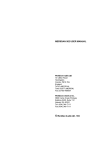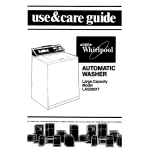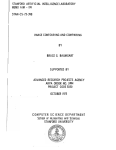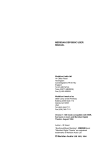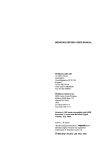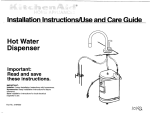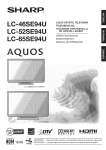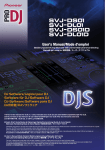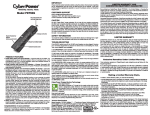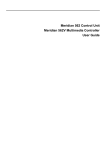Download Meridian 204 User manual
Transcript
MERIDIAN 204 USER MANUAL I Boothroyd Stuart Ltd 13 Clifton Road Huntingdon Cambs. PE18 7EJ England Tel (0) 480 52144 Telex 32577 (MERIDN) Fax (0) 480 459934 I Boothroyd Stuart Ltd. Copyright 3 July 1991 (c) Author, Rik Bean CONTENTS 1 2 2.1 3 4 5 6 6.1 6.2 6.3 6.4 6.5 6.6 6.7 6.8 7 8 8.1 8.2 8.3 8.4 9 9.1 9.2 9.3 10 10.1 10.2 10.3 10.4 10.5 10.6 11 11.1 12 12.1 12.2 12.3 12.4 13 13.1 13.2 13.3 13.4 13.5 14 Introduction, 1 About this manual, 1 Conventions used in the manual, 1 About the 200-Series, 1 Unpacking your 204 tuner, 1 Accessories, 1 Installing your 204 Tuner, 2 General precautions, 2 Connections, 2 If you have a 201 Preamplifier, 2 207 or 208 as your preamplifier, 2 201 and a Meridian, CD Player, 2 Using D600 Loudspeakers, 2 No other Meridian equipment, 2 Antenna connection, 2 Siting, 2 Setting up the 204,3 Checking, 3 If all is well, 3 If there is a problem, 3 Standby, 3 Starting up the 204,3 Incorrect display, 3 Turning the tuner off, 3 The Display key, 3 Tuning the 204,3 Presets, 3 Search tuning, 3 Storing preset frequencies, 4 Setting the tuning threshold, 4 To vary the tuning threshold, 4 Step tuning, 4 Setting the clock, 5 To set the correct time, 5 Using the 204 as a timer, 5 Setting the timer, 5 Setting the timer condition, 5 Using a Meridian Compact Disc Player with the timer, 5 Controlling other equipment, 5 Other features, 6 Automatic station selection on power up, 6 Changing the default display, 6 Time display in Standby mode, 6 Signal strength display, 6 Centre-tuning indicator, 6 Memory facilities, 6 15 15.1 15.2 15.3 15.4 16 16.1 16.2 17 17.1 17.2 18 19 20 20.1 20.2 21 22 23 24 25 Problems, 6 Dealing with power disturbances, 6 Dealing with memory disturbances, 6 Resetting the 201,6 Persistent problems, 7 Using the 209 Remote control, 7 Bringing the system out of standby, 7 Selecting a different preset, 7 Using 204 with D600s,7 Exiting standby, 7 Selecting a different preset, 7 Getting the best from your 204,7 Cleaning, 7 Help, 8 No sound, 8 Keys not working, 8 Maintenance & Service, 8 Radio interference, 8 Guarantee, 8 A quick operating guide, 9 Specification, 10 1 Introduction 3 About the 200-Series The Meridian 204 Tuner is part of the 200-Series of advanced high fidelity equipment. Used with other components in the range, it can offer the music lover much more than just very high quality FM radio. The 204 is a sophisticated device. As a result, this manual has been divided into sections covering each group of operations. You are advised to read through the whole manual before using your 204 for the first time, particularly if you are using it with other 200-Series components. However, for those of you who are familiar with high fidelity equipment and who cannot wait to get the tuner working, we have also provided a ‘quick guide’. In purchasing a Meridian 204 Tuner, you have acquired an advanced piece of equipment which will continue to bring you listening pleasure for many years. This manual will enable you to get the most from it. The Meridian 200-Series of high fidelity equipment is probably the most sophisticated family of hi-fi products currently available. It has been developed to operate at a variety of levels, from simple installations to a whole-house musicmanagement system. The range of components in the 200-Series ensure that a Meridian system will satisfy the needs of any user. The 204 Tuner features fully-synthesised tuning. Its circuitry has been carefully optimised to provide the highest quality of sound available from broadcast FM radio signals. Despite its high performance, each piece of equipment in the 200-Series has been designed for ease of use, with microprocessor control being applied throughout the range to simplify operation. We have also paid great attention to the appearance of the units, and much care has been taken in the selection of the materials used, to ensure that your Meridian 200-Series equipment will look as good in years to come as it does now. 2 About this manual This manual deals with the day-to-day operation of the 204. Once you become familiar with it, you will find that you do not need to refer to these instructions very often. In any manual of this nature, some technical terms must be used. We will explain these when we first introduce them. 2.1 Conventions used in the manual A number in the range 201-220 refers to a component in the Meridian 200-Series range of audio equipment, unless otherwise indicated, for example ‘the socket marked 201’. Whenever a key name i s printed in bold typeface, it means that you should press this key. When a series of key strokes are required, for example press Mode/Store then press Timer, the key names will be separated by a hyphen, that is Mode/Store Timer. If the key name is not in bold type, it indicates that the course of action is not required at present, for example ‘if you want to change the display, press Display’ means you can do this, but it is not essential as part of the operation currently being discussed. Text between square brackets indicates the appearance of the display on the front of the 204, another 200-Series product or on the D600 digital audio loudspeakers. For instance, [P. 231 is the information displayed by the 204 when it is tuned to preset 23 and the preset-number display is selected. When we refer to a default setting, we mean the one that will be selected if you do nothing to change it. For example, when you first set up your 204, the default display is frequency. - 4 Unpacking your 204 Tuner On opening the carton, you should have found the following parts: Meridian 204 FM Tuner Powercord w Network lead (204-201) labelled ‘Q-Lead’ This manual If any of these items are missing, please contact your dealer immediately. We suggest that you retain the packing as it is designed to offer the unit maximum protection whilst in transit, AIthough d I 200-Series components have been designed to be robust, they should obviously be well protected when they are being transported. . . 5 Accessories The following accessories are available from your dealer: Meridian 209 Remote control unit Network lead (204-206) labelled ‘A-Lead’ Network lead (204-208) labelled ‘B-Lead’ Network lead (204-201) labelled ‘P-Lead’ Power cord (Europe) Power cord (USA & Canada) In case of difficulty, they can also be ordered directly from the factory, the address of which can be found on the front of this manual. Please note that you can only use the 209 Remote control unit with your 204 Tuner if you also have either a 201 Preamplifier or a Meridian 206, 207 or 208 Compact Disc player in your system. ... .. 204 Page 1 6 Installing your 204 Tuner 6.1 General precautions Before carrying out any installation, you should first ensure that the tuner is marked with the correct voltage for your local AC supply. If this is not the case, do not proceed with these instructions, but contact your dealer instead. As a general rule, you should not make any connections to the tuner, or to any other component in your system, whilst the AC power supply is connected and switched on. 6.2 Connections You will need to connect the 204 Tuner to your amplifier with a twin-screened audio cable or a pair of single-screened audio cables. These can have a considerable effect on the quality of the sound, and we advise you to seek your dealer’s advice on the best type for your system. The connections you make will depend on other components in your system. . . 6.3 If you have a 201 Preamplifier Connect the sockets marked ‘Output’ on the rear of the 204 to the Radio input on the rear of the 201. Connect the socket marked ‘201’ on the rear of the tuner to the socket marked ‘200 COMMS’ on the rear of the Preamplifier using the QLead supplied with the 204. . . 6.4 207 or 208 as your preamplifier Connect the sockets marked ‘Output’ on the rear of the 204 to the input sockets marked ‘Line’ on the rear of the Compact Disc Player. Connect the socket marked ‘CD’ on the rear of the 204 to the socket marked ‘200 COMMS’ on the rear of the Compact Disc Player using the B-Lead (208) or P-Lead (207) supplied with the Compact Disc player. ONLY use the Q-Lead between the tuner and the preamplifier, never between the tuner and the Compact Disc player. . . 6.5 201 and a Meridian CD Player Connect the sockets marked ‘Output’ on the rear of the 204 to the Radio input on the rear of the 201. Connect the socket marked ‘201’ on the rear of the Tuner to the socket marked ‘200 COMMS’ on the rear of the Preamplifier using the QLead supplied with the 204 Connect the socket marked ‘CD’ on the rear of the 204 to the socket marked ‘200 COMMS’ on the rear of the Compact Disc Player using the A-Lead (206), B-Lead (208) or P-Lead (207) supplied with the Compact Disc player. ONLY use the Q-Lead between the tuner and the preamplifier, never between the tuner and the Compact Disc player. . 204 Page 2 6.6 Using D600 Loudspeakers Connect the sockets marked ‘Output’ on the tuner to either an analogue input on the D600s, the Radio input on the 201, or the Line input on a 207 or 208 Compact Disc Player. Connect the socket marked ‘CD’ on the 204 to the M-Lead supplied with the D6OOs. Follow the instructions in the D600 manual. The D600s are fully-programmable and you should consult your manual before deciding which input to use. If you have any doubts, your dealer will be able to help you. 6.7 No other Meridian equipment Connect the sockets marked ‘Output’ OF the rear of the 204 to an appropriate input on your amplifier. You should consult the manufacturer’s manual to determine which input to use, but generally it will be labelled ‘Tuner’ or ‘Line’. DO NOT, under any circumstances, connect anything to the sockets marked ‘201/2’ or ‘CD’ on the rear of the tuner. 6.8 Antenna connection In all cases, a suitable VHF antenna or VHF cable signal must be connected to the socket marked ‘RF input’ on the rear of the tuner. You are advised to use a high-quality, low-loss co-axial cable. Cables which have a solid screen will give superior performance. Please note that the antenna must be intended for unbalanced (i.e. coaxial) connection. Antennas intended for, or connected with ribbon cable are unsuitable. If your antenna uses a ribbon cable then ask your dealer for a balun or consider having it reconnected. Ribbon cables are not acceptably proof against RF interference. Please refer to the section on VHF reception for more specific advice. 7 Siting The 204 should not be placed on top of a power amplifier, but it can be stacked on either the 201 Preamplifier or a Meridian Compact Disc Player. You should avoid sites where: it would be subjected to direct sunlight it is near a heat source, for example a central heating radiator it could be subjected to strong radiation, for example very close to a television connecting cables may be subject to interf erence Try to keep all power cables and network leads away from signal cables, which includes audio, antenna and loudspeaker cables. Some time spent carefully laying out the cables will repay you with the best performance later. . . . . 8 Setting up the 204 9.2 Turning the tuner off 8.1 Checking If you are using the 204 as part of a system of 200Series components or with D600s, bringing any one of the other units out of standby will activate all of them. Similarly, pressing Standby on one unit will set all units into standby state if they are connected by Network leads. If you are not using your 204 with other Meridian equipment, you can switch it on and off using the power switch on the rear panel. Before turning on the power, check once again that you have made all the connections correctly and that you have not disturbed any existing connections in the process. 8.2 If all is well = turn on the power switch at the rear of the unit. The display will illuminate briefly, [----I, and then extinguish to leave a small point, [ 1. . 8.3 If there is a problem Check the integrity of your power connections, including any fuses in your supply. If the display is still not illuminated and the rest of your system is functioning, contact your dealer for help. 8.4 Standby The entire 200-Series is designed to be left connected to AC power at all times. This standby state ensures that the components operate at maximum efficiency from the moment you start listening. It is perfectly safe and consumes a negligible amount of power 204 consumes around 5W. However, when you are not going to use your system for an extended period, for example when you are going on holiday, we would advise you to disconnect it from the AC power supply. - 9 Starting up the 204 To start up the 204, press any of the six numbered keys, that is 1...6 . The display should now show the frequency stored in the preset you have selected. If you have just turned the unit on for the first time, this will be one of the factory-set defaults. These are: ' preset 2, top of the band preset 3,middle of the band all others, bottom of the band 9.1 Incorrect display If the display is incorrect, switch the unit off using the power switch on the rear panel. Wait for a few seconds, then turn the power on again whilst holding down either the Start Time or Stop Time keys on the front panel for the first 2-3 seconds. This resets the memory of the 204 to its default state. Section 15 of this manual covers resetting the 204 in more detail. If you have just taken the 204 out of its box and are setting it up for the first time, it is a good idea to switch it on in this way. 9.3 The Display key Before we discuss tuning the 204 we should mention the Display key. When pressed, it cycles through the three display modes of the tuner. In order, these are frequency, time and preset number. The time and timer functions will be discussed more fully in Section 11. For now, try pressing Display until you are familiar with its operation. Before attempting to tune the receiver, you should select the frequency mode. 10 Tuning the 204 The 204 Tuner uses advanced circuit technology to achieve perfect tuning with the minimum of user-intetvention. There are three ways of selecting the station you require, preset, search and step tuning. 10.1 Presets It will usually be most convenient to have commonly used stations available as preset selections. You can have up to 18 of these in three banks. The first group, 1-6, are available directly from the numbered keys 1-6. To access the other two groups, you must first press the key marked 10+ or the key marked 20+, followed by the number you want. When you press a key, the display will change depending on the key you pressed. If you press a number from 1 to 6, it will show [S. #I, where # is the number you pressed. The 'S' stands for select. On the other hand, if you press either 10+ or 20+, the display shows [S. 1J or [S. 2J. In this case, the tuner is indicating that you should enter a second digit to select a preset in the range 11-1 6 or 21-26. Obviously, it will make sense to have the six mostused stations in the first group of presets. When the 204 leaves the factory, or after being reset, all 18 presets are retuned to the factory defaults. The actual frequencies required must be set up on site, and to do this, you will need to employ one of the other two methods available. 10.2 Search tuning In its default state, the 204 will employ search tuning. ' Press the Top Green key, and the frequency display will start to increase as the tuner looks for a signal. 204 Page 3 e e As it does this, you will notice the yellow light on the front panel, marked ‘SOKHz’, flickers. The 204 tuner steps through the VHF band in 50KHz intervals, but the display can only show lOOKHz increments. The yellow light indicates that the actual frequency is 50KHz above the indicated frequency. The allocation of VHF frequencies is such that the yellow light will not normally be illuminated when a station is correctly tuned. You can instruct the tuner to search in the other direction by pressing the Bottom Green key. When the 204 finds a station of adequate strength, it will stop searching and display the frequency. If the station is broadcastina in stereo. the red light or I also illumin 10.3 Storing preset frequencies Once you have tuned a station you want to store as a preset: decide which number you wish to allocate to it press Mode/Store-Number. If the station is to be stored in one of the alternative banks of presets: press Mode/Store +I0 Number, or press Mode/Store +20 Number In other words, to store a preset frequency, press Mode/Store followed by the number, or shifted number, you require and to recall it, just press the number, or shifted number. If the station you wish to store is very noisy, or has a weak signal, you may prefer to listen to it in mono. You can do this automatically by pressing Mono before you press Mode/Store Number. This facility applies to all 18 presets. It is worth noting that you do not have to tune your Dreset selections in numerical order and that tti e tuning process will commence from the curr(wt frequency, or, in the first instance, from the example, bottom of the VHF band. Therefore if,-for - - - -. . you wanted to allocate preset 1 to 99.OMHz and preset 2 to 88.5MHz, you would start the tuning process as described above, and when the 204 locked onto the 88.5MHz signal, you would press Mode/Store 2. Then you would press the Top Green key again, and when the 99.OMHz signal had been tuned, press Mode/Store 1 to store the frequency in the tuner’s memory. You can also speed up the process by tuning presets 1,2 and 3 last. This leaves them available to move to the bottom, top or middle of the band, before using the GreenI Keys to locate your desired station. .. .. -- -- - - - 10.4 Setting the tuning threshold We mentioned above that the tuner would only stop when it found a station of adequate strength. This signal strength is preset at the factory, but it can be varied to suit local conditi 204 Page 4 . 10.5 To vary the tuning threshold - press Mode/Store Bottom Green. The display will now show [S.S. 11, which stands for Stop Signal-strength 1. The strength can be set to any figure from 0-7. A setting of 0 will allow the weakest of signals to be tuned. This may be helpful if you are trying to receive distant stations or live in a poor reception area. If you only want to receive strong signals, increase the setting until only those signals are recognised by the 204. To increase the threshold, and tune only strong signals: rn press Top Green To decrease it and allow weaker signals to be tuned: press Bottom Green. As you do this, the number displayed will change. When the required threshold level has been selected: rn press Mode/Store once more to store the new threshold in memory. You will need to experiment to find the best setting for your needs, but you can do no harm by changing the threshold level, so feel free to explore the possibilities. t t a a a %: a . 10.6 Step tuning The third method of tuning the 204 is to employ step tuning. This is broadly similar to search tuning except that you must press one of the green keys for each 50KHz step that you wish to make. Each time you press a green key, the frequency display will increase or decrease by 50KHz. In practice, this means that the digital display will change on every other press, alternate presses switching the yellow light on and off. In the step mode the tuner can scan if you hold the green tuning key down. After pressing for a few seconds the rate of scan will increase, scanning will stop when you release the key. Unlike search mode, the tuner wraps at the ends of the band in step mode from top to bottom and viceversa. This method is less convenient than search tuning, which is why search tuning is selected by the tuner as its default state. To change to step tuning: I press Mode/Store followed by the Top Green key _. .. . ... . -_The display will now read [Srch], pressing the Top Green key again will change this to [Step]. To complete the switch: press Mode/Store again. To change back to search mode tuning, repeat the process, this time the second press of the Top Green key will change the display from [Step] to [Srch]. In other respects, tuning by the step method is identical to tuning by the search method, and any presets you wish to store can be memorised by the same process. . e 12.2 Setting the timer condition VIUUSI~,wrieri r i m switcrieu aispiay couia snow ding the time. ObWII, this particular dis- play will be meaningless. 11.1 Tosc!t the correct time - pressMode/Store Start Time The Hours biutton will illuminate. L-a ---- - A I L L . . . . -I!press either ureen ney ru s e r t r i e riuurs UISplay to the required figure (the 204 uses a 24 hour clock) then press Mins and set the minutes in the same way To complete the operation, press Mode/Store once more. Note that the final press of Mode/Store starts the clock, so for maximum accuracy, press this exactly on the minute. I/--..A- 12 Using the 204 as a timer Your 204 can be used to switch the entire system on (or to a determined condition) and off at predetermined times. For this facility to work, you must have a Meridian system consisting of a preamplifier, and power amplifiers or active loudspeakers. The preamplifier can be a 201, or the preamplifier facilities in a 207 or 208 Compact Disc Player. 12.1 Setting the timeFirst, set the time at whict turn on. To do this: press Start Time the Hours key will light. use me ween Keys KO select the hour required, remembering that a 24 hour clock is used press the Mins key, which will illuminate, and select the required time using the Green Keys Complete the setting operation by pressing Start Time again now press Stop Time the Hours key will light. Use the Green Keys to select the hour required, remembering that a 24 hour clock is used press the Mins key, which will illuminate, and select the required time using the Green Keys ComDlete the settina oDeration bv oressina Now put the system in the state in which you want it to start up: rn select the preset required set the volume and input on the preamplifier rn press Mode/Store Timer on the 204 to store the timer condition in.the complete system. rn press Timer on the 204 to arm the timer. rn press Standby on one of the other components in the system, or use the system as you like in the mean-time. The system will go to the timer condition you have specified when the start time is reached. To show that the timer is armed, a green light will illuminate behind the Timer key on the front panel of the 204. You can operate the system normally at any time up to the start time. When stop time is reached the system will go into standby. - 12.3 Using a Meridian Compact Disc: Player with the timer In a system which includes a 204 Tuner and a Meridian Compact Disc player, you can also cause a CD to play at the start time. The procedure for this is broadly similar. First select the start and stop times as described, then insert the chosen disc in the Compact Disc player: rn press Play, and set the system so you can hear the disc playing at the required volume level m press Mode/Store Timer on the 204 to store the timer condition in the complete system. = press Timer on the 204 to arm the timer. m press Standby on the Compact Disc Player, or use the system as you like in the mean-time. Note that you do not have to select a tuner frequency if you are going to use Compact Disc as your alarm source. The system will go to the timer condition you have specified when the start time is reached. To show that the timer is armed, a green light will illuminate behind the Timer key on the front panel of the 204. You can operate the system normally at any time up to the start time. When stop time is reached the system will go into standby. - 12.4 Timer output The timer function of the 204 also has an external output. This is a 5v output that goes to Ov when the timer function is activated and back to 5v at the end of the timer period. Use of this output is at the discretion of the user. DO NOT connect anything to the socket marked 'Timer Out' on the rear panel of the 204 without seeking advice. If you do, you may damage your tuner. 204 Page 5 1:3 Other features 14 Memory facilities I f1.1 Automatic station selection on PtIwer up As we have said, the 204 Tuner contains a battery- It is often useful to be able to switch on the systein and have the tuner select a pre-determined f relquency. This avoids the need to make two selec:tions, that is Radio (or Line if using a 207 or 208) followed by a preset number. To do this, selec3 the required station, then: m press Mode/Store Number tUlner will now automatically select this channel wtienever it is brought out of standby, unless, of COiurse, you override the choice by pressing a diffei'ent preset. - 1:5.2 Changing the default display Asi you already know, the normal display on the 2014 can show three different types of information. WIhen you first install the tuner, the default is freq"iency. Tc1 select a different default disolav. Dress DisDlav I-epeatedly until the required 'infGrmation is'diiIllayed. The 204 will remember this information Imtil you change it again. 13.3 Time display in Standby mode ... .. . . . .. . ,. y . . tne .. aispiay .. . Lvnen tne tuner is in its s m n a ~ state, . 1. If you prefer, you is normally a single dot, [ cain arrange to have the current time displayed, sirmply press Display when the 204 is in standby. Pr,essing Display repeatedly will toggle this facilitYr, and the 204 will remember the last setting ente red. Whenever the time display is selected a gr'een light, marked 'Time Display', will illuminate or1 the front panel of the tuner. 13.4 Signal strength display The 204 display can also show the signal strength of the current station to help you set the tuner. To select this facility, press Mode/Store Display. The display will now change to [St. #], where # is a number from 1-7. This number will vary from station to station and indicates the strength of the signal from very weak (1) to very strong (7). You can re-tune the 204 in any of the normal ways, whilst maintaining the signal strength display. Do not leave the signal-strength display for normal listening, the measuring process introduces a low-level audio noise which is audible. - 13.5 Centre-tuning indicator - Pressing Mode/Store Mono switches the display to a centre-tuning indicator for diagnostic purposes. When a station is correctly tuned, the display will show [C. 01. Do not leave the centre-tune display for normal listening, the measuring process introduces a low-level audio noise which is audible. 204 Page 6 powered memory, which retains information when the system is turned off, even if the power supply is disconnected. Not only does the 204 remember its own settings, but it will also remember those of a 201 Mkl Preamplifier as long as the two units are connected by a Q-Lead. To use this facility, press Mode Standby on the 201 after the connections have been made to the 204. If you have a 201 Mkll, please refer to its manual for details of how to store its own settings. c c c c c c c c - 15 Problems The Meridian 200-Series hi-fi components are extremely reliable under normal conditions. However, because they are controlled by microprocessors, they can occasionally be susceptible to AC-borne disturbance and static discharges. This is true for any similar appliance, for example video recorders or microwave ovens. 15.1 Dealing with power disturbances If you encounter problems with your system, for example the keys do not work as expected or the display becomes corrupted, try returning the system to standby for a few seconds. If the problems persist, then switch off the AC-power for a short while. This action will cure most problems. 15.2 Dealing with memory disturbances It is possible for the battery-powered memory in the 204 to have become corrupted. If this has happened, the system will remember the fault condition. To overcome such a problem: switch off the AC-power wait a few seconds then turn it on again whilst pressing Start Time or Stop Time on the front of the 204 This restores the system to the default state. You will have to re-tune the 204, reset its clock ect., and reset the 201 default conditions if you have a 201 Mkl. You can avoid the need to reset the 201 by keeping it switched on whilst resetting the 204. 15.3 RI If you have a 201 Mkl, and suspect that it is just the 201 default conditions that have become corrupted, you can carry out a partial reset. To do this, switch off as before, but press Mono when restoring power. If you have a 201 Mkll, please refer to its manual. c L c c r c c c c c l c c l - 1 D c c I- ICE rc e c (z 15.4 Persistent problems 17.1 Exiting standby Such problems are extremely rare, and you are unlikely to experience them. They do not indicate any fault in the 200-Series components, and if the above reset procedures restore normal working, you need take no further action. In the event that the problem persists, please contact your dealer, service agent or the factory for further advice. If your installation is correctly set up, bringing any one unit out of standby will activate the entire system. The normal way to switch on the system therefore, will be to press the required source selector on the 609, that is Radio. If you have already selected a default preset as described above and want to listen to it, you need do no more. 16 Using the 209 Remote control Please note that the 209 can only control the 204 i f t h e system also contains either a 201 Preamplifier or a Meridian Compact Disc player and if the necessary network leads are connected. You cannot alter the display mode, set the time, or set the presets on the 204 remotely. 16.1 Bringing the system out of standby If your installation is correctly set up, bringing any one unit out of standby will activate the entire system. The normal way to switch on the system, therefore, will be to press the required source selector on the 209. If you are using a 201 Preamplifier and wish to listen to the 204, then press Radio. If you are using only a 207 or 208 Compact Disc player, then press Line. If you have already selected a default preset as described above and want to listen to it, you need do no more. 16.2 Selecting a different preset 17.2 Selecting a different preset If you want to listen to a different preset, press one of the Number Keys on the 609. The D600 display will change depending on the key you pressed. If you press a number from 3 to 6, it will show [S. #I, where # is the number you pressed. The ‘S’ stands for select. On the other hand, i f you press either 1 or 2, the display shows [S. 1 1 or [S. 2J. In this case, the D600 is indicating that you can enter a second digit to select a preset in the range 11-1 6 or 21-26. The D600 will wait a short while, to allow you to enter two digits, for example 1 6, before passing the preset number to the 204. Alternatively, press Next to select the next highest preset or Previous to select the next lowest. These keys will step through all 18 presets, wrapping around at each end of the range. (i.e. Next will step from 26 to 1 and Previous from 1 to 26). - 18 Getting the best from your 204 If you want to listen to a different preset, press Preset on the 209, followed by the number required. The display will change depending on the key you pressed. If you press a number from 3 to 6, it will show [S. #I, where # is the number you pressed. The ‘S’ stands for select. On the other hand, if you press either 1 or 2, the display shows [S. 1J or [S. 2J. In this case, the tuner is indicating that you can enter a second digit to select a preset in the range ll-1 6 or 21-26. The Tuner will wait a short while, to allow you to enter two digits, for example 1 6, before switching to the preset number entered. If you want to select a preset in the range 1-6 and do not want to wait, then press 0, followed by the number you require. Once you have pressed Preset, the system will assume all future numbers refer to the 204 presets until you press Track. The Meridian 204 Tuner is a very sophisticated unit, which will deliver superb quality sound. However unless the signal delivered to the antenna socket of the 204 is of sufficient strength and quality, you will not enjoy the maximum benefits of your new tuner. We cannot emphasise enough the importance of a good VHF antenna and downlead. However, as reception conditions vary so much, it is impossible to give more than broad advice, and we recommend, therefore, that you consult your dealer or antenna supplier. He will be familiar with local conditions and will be able to advise you on the right equipment for your installation. Please refer to the notes in section 6.8. In the United Kingdom, advice can also be obtained from BBC Engineering Information, Broadcasting House, London, W1A 1 M , telephone 01927 5040. 17 Using 204 with D600s 19 Cleaning - Please note that you cannot alter the display mode, set the time, or set the presets on the 204 remotely. The main body of the 204 is epoxy-enamelled aluminium. To clean the case, use a cloth barely moistened with a solution of mild detergent and water. Disconnect the power cord before cleaning the unit. Ensure that no water is allowed to get inside the case and do not reconnect the power until you are certain that the 204 is completely dry. 204 Page 7 1 The display panel is glass, the key pad is plastic. Use a barely damp chamois leather on these areas. Do not use abrasive cleaners on any part of the Tuner. The audio sockets on the rear of the 204 are gold-plated and need no cleaning if gold-plated phono plugs are used. Otherwise, we recommend that you remove and replace the plugs at least once a year. A proprietary contact cleaner can be 20 Help The wide range of facilities available from the Meridian 200-Series can occasionally mean that even the most experienced user can run into trouble. This section is designed to help you when things do not appear to be working normally. 20.1 Nosound If no sound can be heard from your loudspeakers, the most likely causes are: No power is reaching the 204 or the entire system The audio cable between the 204 and your preamplifier has become disconnected The preamplifier is not turned on; if other Meridian 200-Series components are in the system, they are not connected to the 204 with the network leads supplied The preamplifier is not set for radio input or is in tape-monitoring mode The volume control is set to its minimum or is in mute condition The threshold level on the 204 has been set too high, preventing any stations being received, see section 10.5. 20.2 Keys not working If the keys on the 204 are not working correctly, for example they produce unexpected results, the microprocessor needs to be reset. Refer to section 15 for full details. This type of problem can also affect other Meridian 200-Series units connected to the 204 by network leads. 21 Maintenance & Service The Meridian 200-Series of hi-fi components have been carefully designed to give years of untroubled service. There are no user-serviceable parts inside the case, nor do the units require any form of maintenance. In the unlikely event that your 204 Tuner fails to function correctly, and you are unable to restore normal operation by resetting the unit as described in section 15, it should be returned, in its original packing, to your Meridian dealer. In case of difficulty, please write: 204 Page 8 In the UK, Boothroyd Stuart Ltd. 13 Clifton Road, Huntingdon, Cambridgeshire, PE18 7EJ. In the USA, Meridian America Inc. 14120-K Sullyfield Circle, Chantilly, VA 22021 Tel(703) 818 3028, Fax (703) 830 7825 Outside the UK, contact the importing agent for the territory. A list of Meridian agents abroad is available from the above addresses. No responsibility can be accepted for the Tuner whilst in transit to the factory or an agent and customers are, therefore, advised to insure the unit. 22 Radio interference NOTE the 204 is a radio tuner containing a microprocessor which has been designed to very high standards of Electromagnetic compatibility. FCC WARNING: This equipment generates, uses and can radiate radio-frequency energy and, if not installed and used correctly in accordance with our instructions, may cause interference to radio communications or radio and television reception. It has been type-tested and complies with the limits set out in: rn Subpart J, Part 15 of FCC Rules for a Class B computing device. These limits are intended to provide reasonable protection against such interference in home installations. If this equipment does cause or suffer from interference to/from radio or television reception, then the following measures should be tried: rn Reorient the receiving antenna or route the antenna cable of the receiver as far as possible from the 204 and its cabling. = Ensure that the receiver uses well-screened antenna cable. Relocate the receiver with respect to the 204. Connect the receiver and the 204 to different AC outlets. rn If the problem persists, contact your dealer. .. EEC This product has been designed to comply with EN55013 and EN55020. REMEMBER to switch off all units before changing any connections. 23 Guarantee The 204 Tuner is guaranteed against defects in material and workmanship for 12 months from the date of purchase. The guarantee is void if the Tuner has been subjected to misuse, accident or negligence, or has been in any way modified without the written authorisation of Boothroyd Stuart Ltd. Note that connecting anything other than the correct network leads to the sockets marked ‘201’ and 3 2 ‘CD’ may cause damage to tlhe 204 which will not be covered by this guarantele. Similarly, connecting incompatible equipment ’to the socket marked ‘Timer Out’ may cause dam: age to the 204 which will not be covered by this gparantee. Attempted startticinn --. .-.. hv ‘, I t n a t t t h n r i c m r l people may also invalidate this guarantee. Labour and carriage charges are not covered unless by local agreement. When seeking service under guarantee, proof of the date of purchase will be required. Outside the UK, local warranty liability is restricted to equipment purchased within the territory. Our agents abroad are only under contractual obligation to service under guarantee equipment sold through them. They are entitled to make a non-refundable charge for any service carried out on other equipment. This guarantee does not limit your statutory rights within the United Kingdom. - . 24 A quick operating guide This section is a quick reminder of the operation of the tuner and should not be seen as a substitute for the rest of the manual. 123 These keys select the six main preset 456 stations and bring the 204 out of standby. 1o+ 20+ These are used as shift keys, before pressing the number keys 1 to 6. When used, t h e y a l l o w access t o t h e secondary presets 11-1 6 and 21-26. Green These keys are primarily used to tune the 204, the top key increases the frequency, the bottom key decreases it. A secondary function is to set the displayed and timer times, the type of tuning and the tuning threshold. Mono Selects mono reception. Pressing it repeatedly will toggle between stereo and mono, in the mono state the key will illuminate and the red light on the front panel will extinguish. A centre-tuning display can also be selected by pressing Mode/Store Mono. Display If the tuner is in standby, pressing this key will toggle between a blank display and a time display. If the tuner is on, the key cycles through the three possible displays: frequency, time and preset number. The strength of received signals can also be displayed by pressing Mode/Store Display. Note that whilst this display is selected, the Mode/Store key will illuminate and the tuner will not respond to pressing the Standby key on any other component of the system, that is you cannot turn the tuner off. To revert to the normal display, press Mode/Store again. - Mode/Store This key is always used in conjunction with others and has several functions: To store presets. First select the required frequency using the Green Keys, then press Mode/Store followed by a number. For example to store the frequency in preset 1, press Mode/Store 1 and to store it in preset 12, press Mode/Store 1O+ 2. To change from Search to Step tuning, or vice versa, press Mode/Store Top Green. The display will now show the current state. Pressing the Top Green k e y w i l l t o g g l e t h e state, press Mode/Store again to select the required method. To adjust the tuning threshold, press Mode/Store Bottom Green. Now adjust the level using the Green Keys, then store the value with Mode/Store. To store the timer preset, select it using either manual tuning or a preset, then press Mode/Store Timer. To identify the version number of the tuner’s operating software, press Mode/Store Stop Time when the tuner is in stendby. Start Time To set the start time, press Start Time. A time will be displayed. The Hours key will illuminate. Use the Green Keys to select the correct figure, then press Mins and adjust as required. Complete the operation by pressing Start Time again. To set the displayed time is identical except that, before pressing Start Time you must first press Mode/Store. Stop Time To set the stop time, press Stop Time. A time will be displayed. The Hours will illuminate. Use the Green Keys to select the correct figure, then press Mins and adjust as required. Complete the operation by pressing Stop Time again. Timer To prime the timer, press Timer and the green light behind the key will illuminate. To cancel the alarm, press Timer again, the green light will extinguish. - - - - - - - - 204 Page 9 25 Specification Frequency range Sensitivity Ultimate quieting Distortion (input signal 1KHz) Selectivity Capture ratio IF rejection AM suppression Crosstalk at 1KHz Frequency response Output level Output impedance RF input De-emphasis Power input Dimensions Weight - 88 108MHz 30dB quieting Mono 1.5pV 50dB quieting Mono 4.0pV Stereo 23rV >75dB Mono ~0.2% Stereo ~0.4% 56dB 1.5dB 1OOdB >55dB 40dB typ, depends on signal strength 20Hz 15KHZ *ldB OdB 775mV 47ohm 75ohm unbalanced 50 rSec or 75 pSec 100 125V or 200 250V 50 6 0 k , 6VA 159mm x 310mm x 1OOmm ( W x L x H) 3 kg - - - - IrC e ez 204 Page 70 d
















